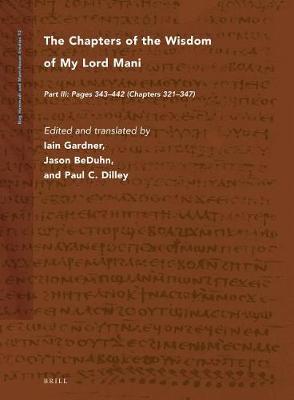Nag Hammadi and Manichaean Studies
3 primary works
Book 37
The Kephalaia of the Teacher is the most detailed account available to modern scholarship of the teachings of Mani, and of the universal religion that he founded as the final successor to Buddha, Zarathushtra and Jesus. This volume provides the first complete English translation of the Coptic text (c. 400 CE), together with introduction, commentaries and indices.
Topics include the apostleship of Mani, the practices of the Manichaean community, accounts of the heavenly and demonic beings and worlds, as well as discussions of astrology and religious psychology.
In Manichaeism many of the gnostic and dualistic themes of early Christianity achieved the status of a world religion, and the subject is the heir to contemporary interest in heterodoxy and the deconstruction of received histories (see the Nag Hammadi codices).
Topics include the apostleship of Mani, the practices of the Manichaean community, accounts of the heavenly and demonic beings and worlds, as well as discussions of astrology and religious psychology.
In Manichaeism many of the gnostic and dualistic themes of early Christianity achieved the status of a world religion, and the subject is the heir to contemporary interest in heterodoxy and the deconstruction of received histories (see the Nag Hammadi codices).
Book 87
Mani at the Court of the Persian Kings
by Iain Gardner, Jason D Beduhn, and Paul Dilley
Published 1 January 2014
In Mani at the Court of the Persian Kings the authors explore evidence arising from their project to edit the Chester Beatty Kephalaia codex. This new text presents Mani at the heart of Sasanian Iran in dialogue with its sages and nobles, acting as a cultural mediator between East and West and interpreter of Christian, Iranian, and Indian traditions. Nine chapters study Mani's appropriation of the 'law of Zarades' and of Iranian epic; suggest a new understanding of his last days; and analyse his formative role in the history of late antique religions.
These interdisciplinary studies advance research in several fields and will be of interest to scholars of Manichaeism, Sasanian Iran, and the development of religions in Late Antiquity.
These interdisciplinary studies advance research in several fields and will be of interest to scholars of Manichaeism, Sasanian Iran, and the development of religions in Late Antiquity.
Book 92
The Chapters of the Wisdom of My Lord Mani
by Iain Gardner, Jason D Beduhn, and Paul Dilley
Published 12 June 2018
The Chapters of the Wisdom of My Lord Mani, a Coptic papyrus codex preserved at the Chester Beatty Library in Dublin, describes Mani's mission, teachings and debates with sages in the courts of the Sasanian empire during the reign of Shapur I; with an extended account of his last days and death under Bahram I. The text offers an unprecedented new source for the history of religions in Late Antiquity, including interactions of Manichaean, Zoroastrian, Christian, Jewish, and Buddhist traditions in Iran, remarkably transmitted into the Mediterranean world as part of Manichaean missionary literature. This is the first of four fascicles constituting the editio princeps, based on enhanced digital and multispectral imaging and extended autoptic study of the manuscript.


